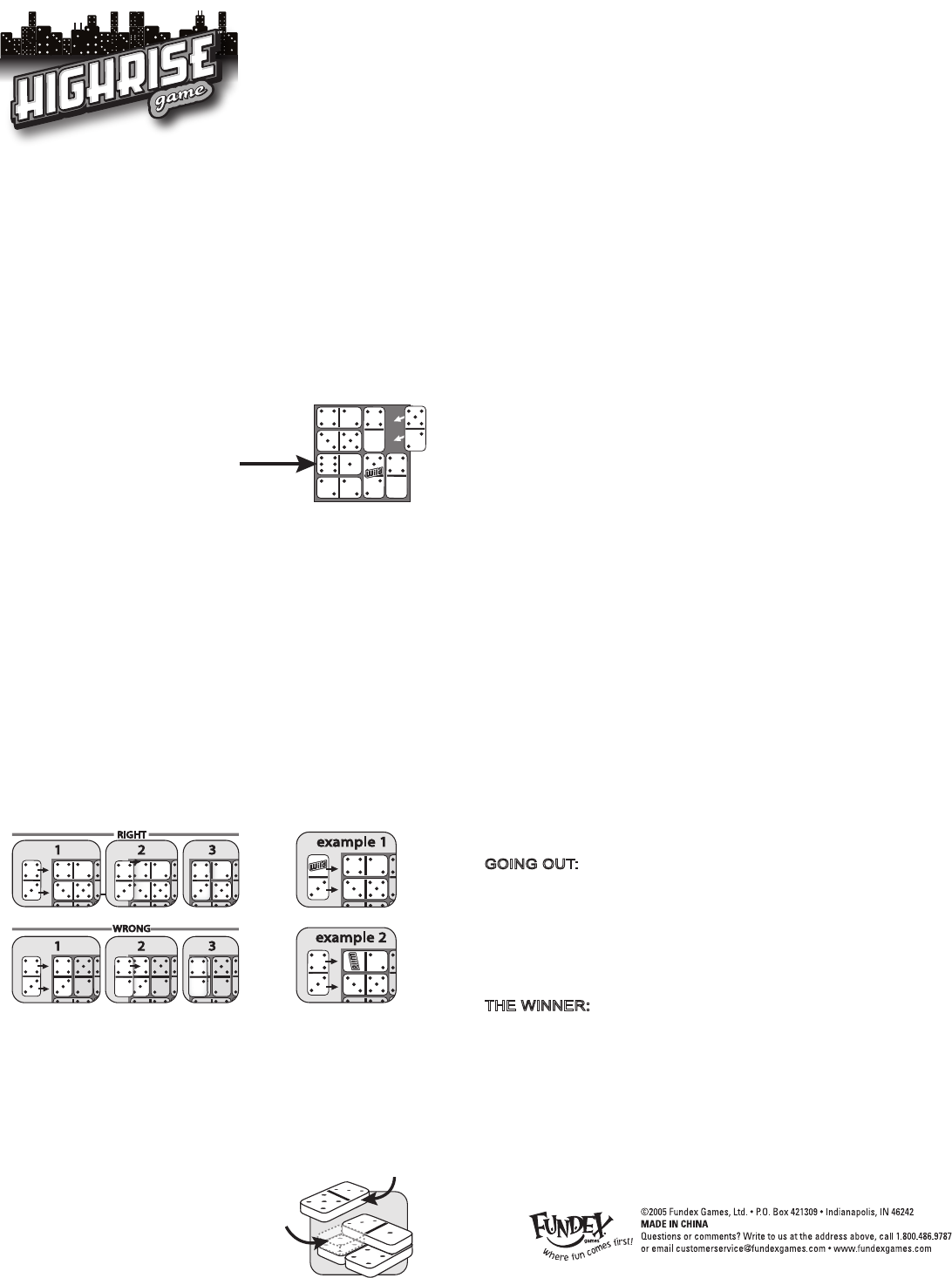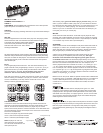
1. Lay clear spacer
2. Play the 5–3 on top
INSTRUCTIONS
NUMBER OF PLAYERS:
2–4
AGES:
8+
CONTENTS:
One HIGHRISE base, 36 dominoes and 12 clear spacers
(Paper and pencil are needed for scoring).
OBJECT:
To score points by laying matching dominoes on top of dominoes already in
the base.
SET-UP:
Place the Highrise base in the center of the play area. One player places
all dominoes face down near the base and mixes them thoroughly.
That player then randomly selects eight dominoes,
one at a time,and places them face up, side by
side inthe base until it is full. This is known
as filling the basement.
All players each take five of the remaining dominoes to form their hand of
dominoes. Players should then arrange their dominoes so they are facing
them, but not visible to other players. The dominoes not selected become
the draw pile and are put off to the side. Place the twelve clear spacers
near the draw pile.
PLAY:
The youngest player has the first turn. The next hand is started by the
player to the left of the youngest player, and so on. In your turn, you try to
place a domino from your hand directly onto the halves of two different
dominoes already in the base. You must always cover over two
dominoes. You can never directly cover just one domino.
Each half on the domino you place must match the number on the domino
half it is covering. For example, if you play a 4–3 domino, the 4 half must
cover a 4 half already on the tray, and the 3 half must cover a 3 half
already on the tray (see examples below).
CLEAR SPACERS:
In the above cases, both domino halves being covered had to be from
dominoes on the same level(Otherwise, the newly placed domino would
slide off, and this is not allowed). However, a player may use a clear
spacer, which can be placed on a domino half which is one level lower than
the other half being covered. For example, if a 5 and a 3 are to be covered,
but the 5 is one level lower
than the 3, the player may place a clear spacer
on the 5, then cover the spacer and the 3
with a 5–3 domino (see example to right).
NOTE: A player can use one
clear spacer per turn if needed.
You can never use more than one
clear spacer per turn.
After making a play (you must make a play if you have one), your turn
ends. If you are unable to make a play, then you must draw one domino
from the draw pile. After drawing the domino, you must either play it if you
can, or end your turn without playing. You never draw more than one
domino in your turn. If there are no more dominoes in the draw pile, you
must pass your turn if you cannot play.
WILDS:
Some dominoes have wild halves. A wild half may be played to cover
anything, and a wild half already on the tray may be covered by anything.
For example, a wild–3 domino may cover a 4–3
(see example 1).
Likewise,
a 4–3 domino may cover a wild–3 (see example 2).
SCORING:
Select someone to be the Scorekeeper. That person writes the names of
the players, in order of turn, across the top of a sheet of paper so each
player has their own scoring column. The player in the left-most
column
(the youngest player) should be the player who starts the game.
A player’s score is determined by the total number of points on the
domino just played, multiplied by the level of the play. The eight
dominoes in the basement at the beginning of the game are not
considered to be a level. The dominoes played directly on top of them
(at the “street level”) are considered level one. So, any domino played at
level one is scored as its total points times one. For example, a 5–2
domino played at level one is scored as 7 times 1, or 7 points [(5
+
2) x 1
= 7].
Any domino played directly on top of level one is considered
level
two. For example, a 6–3 domino played on level two is scored as 9 times
2, or 18 points [(6
+
3) x 2 = 18]. Scoring tends to go higher as the game
progresses. For example, a 6–2 domino played on level five is scored as 8
times 5, or 40 points [(6
+
2) x 5 = 40].
Blanks count as zero points. Wilds are special and their value is determined
by what they cover. For example, a Wild half that covers a 4 is counted as a
4. Also, a Wild half placed on top of a spacer that is on top of a 4 is still
counted as a 4. In the rare case that a Wild covers a Wild, the value is
counted as a 7.
GOING OUT:
If one player plays their last domino, that player has “gone out.” After
scoring the points earned for the final play, that player also scores all the
unplayed points in the opponents’ hands (Wild halves count seven points
and blanks count zero points). If no player goes out, and no one can make
any more plays, the hand ends and each player must subtract the points
remaining in their hand from their score.
THE WINNER:
At the end of the hand, the player with the most points is the winner. Players
may play several hands and keep a running total. At the end of a hand, if at
least one player has reached a running total of 300 points (or an agreed
upon total before the games begins), then the player with highest score is
the winner.



